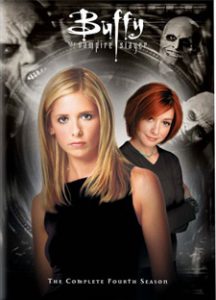I had always ranked it as the second-to-worst season (in front of Season 7), but I liked “Buffy the Vampire Slayer” Season 4 (1999-2000, WB) a lot more on this rewatching. I think it’s best viewed as a separate entity from the superior Season 3 and “Angel” Season 1.
Let’s get the bad news out of the way: The overall season arc doesn’t work. “Buffy” just didn’t have the budget to do the Initiative right (although it initially looks like an impressive military installation, a lot of the soldier-speak and whatnot comes off as play-acting).
Although George Hertzberg is pretty good as Adam, it’s hard to forget that a high school kid created a Frankenstein’s monster all by himself back in Season 2’s “Some Assembly Required.” Professor Walsh, Adam and the Initiative simply aren’t worthy villains for our gang.

“Buffy the Vampire Slayer” Season 4 (1999-2000)
WB, 22 episodes
Creator: Joss Whedon
Stars: Sarah Michelle Gellar, Alyson Hannigan, Nicholas Brendon
The good news is that the writers seemed to realize the Initiative didn’t have proper heft as a season-long Big Bad, so they diverted from it a lot, making Riley (Marc Blucas) more of a member of the Scooby Gang than of the Initiative (which, of course, was his arc anyway).
Enter Riley and Tara
As a Buffy-Angel shipper, I used to despise Riley; after this viewing, I kinda like him. I even chuckled at many of Blucas’ line deliveries. The actor was in a difficult position, being added to the cast before his character had even met all of the gang, and being asked to do weird things like being possessed by a chip in “Primeval.”
A character who earns her place in the Scoobies much more smoothly is Tara (Amber Benson). On first viewing, I admit I was clueless that the writers were telling a romance story with Willow and Tara (although thanks to Internet buzz, I probably realized it before Buffy does in episode 19).
On this viewing, it’s remarkable how naïve I was: Willow and Tara have a very cute, more-than-friends chemistry from the get-go. I’ve always liked Tara, but on this viewing, I have to say she’s my favorite character of the season (beating out even Anya and Spike, who have much less to do in Season 4 than I remembered). Part of the reason she’s so likable is that she respects Willow’s established group of friends; the character doesn’t seem forced on viewers like Riley is.
As noted, the writers divert from the main arc a lot, delivering a bevy of actor-friendly experimental episodes. In this season, Sarah Michelle Gellar gets to play Faith, a drunken Cave Slayer, and a victim of a love spell. Eliza Dushku plays Buffy. Anthony Stewart Head plays Giles-as-a-Fyarl- demon. And James Marsters finds a gentler — but funnier than ever — side to Spike when he gets a V-chip in his head courtesy of the Initiative.

But the best (and most devastating) episodes, as with many “Buffy” seasons, are about the end of a relationship:
1 and 2. “Wild at Heart” (episode 6, written by Marti Noxon) and “New Moon Rising” (19, Noxon)
The real-world pain of a breakup comes through in “Wild at Heart” thanks to a series of emotional scenes made more jarring by Alyson Hannigan’s ability to portray Willow’s sadness at Oz’s cheating and departure. “New Moon Rising,” where Oz returns to Sunnydale in control of his lycanthropy (or so he thinks), is an even more impressive feat of writing as Noxon honestly portrays every side of the love triangle. In the end, we’re thrilled that Willow and Tara are together, yet we also miss Oz.
Noxon shows respect for the odd man out with that last scene in the van where Willow tells Oz, “I feel like some part of me will always be waiting for you.” “New Moon Rising” is also the strongest Riley episode, as he firmly chooses the Scoobies over the Initiative and rescues Oz. These episodes play better than they did on their original airings, when I was distracted by the depressing real-world knowledge that Seth Green was leaving “Buffy.” In retrospect, it’s hard to imagine such powerful Oz episodes if he remained a cast regular.
3. “Who Are You” (16, Joss Whedon)
On my first viewing of this classic body-switch yarn, it was Gellar’s performance as Faith that really stood out, but with subsequent viewings, I’ve appreciated Dushku’s turn as Buffy more and more. Whedon finds an innovative way to kick the “Redemption of Faith” arc into high gear.
“Because it’s wrong” starts off as a joke but gains meaning after Faith spends some time in Buffy’s skin. Likewise, we sense that Buffy — having been held by Watchers who see her as scum — feels sympathy for Faith, although that notion wouldn’t be continued in the “Angel” crossover.
4. “A New Man” (12, Jane Espenson)
I love the way chaos-worshipping Ethan Rayne pops into Sunnydale to cause mischief (see also “Halloween,” “The Dark Age” and “Band Candy”), but his farewell episode is my favorite as he turns Giles into a demon. The sight of Head in demon prosthetics and makeup is hilarious enough, but the writers hit a home run throughout the hour.
A highlight, of course, is when Giles gets out of his car simply to harass Maggie Walsh, whom he sees on the sidewalk. Spike’s negotiating skills (or lack thereof) are also amusing, as he agrees to help Giles for $100.
5. “Something Blue” (9, Tracey Forbes)
Continuing with the trend of the actors getting to stretch their wings in Season 4, Willow’s spell goes awry and Buffy and Spike think they’re in love (something that would, of course, foreshadow future seasons, although it seemed humorously bizarre at the time).
My favorite parts of this underrated episode are Giles’ continually perplexed and disgusted facial expressions in reaction to the lovebirds. And in a nice blink-and-you’ll-miss-it gag, the briefly de-ratted Amy makes her only appearance of Season 4 (thankfully, she’ll get more to do in Season 6).
6. “Hush” (10, Whedon)
This pretty-much-perfect dialogue-free episode rightfully stands as a high mark of the ingenuity of Whedon and “Buffy.” In addition to being a challenge for the actors, it’s great that Christophe Beck — one of TV’s all-time greatest composers — gets to bring his work to the forefront.
7. “The Freshman” (1, Whedon)
Whedon gets the tone of this “off to college” threshold episode exactly right with little details such as the in-over-her-head Buffy visiting her mom only to find that her bedroom has been turned into a storage facility. It’s always great to see Buffy struggling with everyday life even as she gets more comfortable with being the Chosen One.
8. “Superstar” (17, Espenson)
Although he’d end up getting to do even more in Season 6, it was cool to see fan-favorite background character Jonathan (Danny Strong, who has gone on to a successful career as a writer) get a showcase alternate-reality episode where he’s the protector of Sunnydale (in addition to somehow being an NBA superstar and Hollywood idol).
9. “This Year’s Girl” (15, Douglas Petrie)
Although the real fireworks come in “Who Are You,” it’s great to have Faith back here. The director and editor nicely build up the suspense of the Slayer inevitably waking from her coma. Her viciousness, combined with the pain conveyed by Dushku’s facial expressions, effectively launch the four-part “Redemption of Faith” arc that would cross over onto “Angel.”
10. “Living Conditions” (2, Noxon)
This episode nails the obvious “roommate from hell” story thanks to Dagney Kerr’s bluntly annoying yet sweet turn as Kathy, who loves Cher, borrows Buffy’s clothes without asking and labels everything in the refrigerator, right down to individual eggs. In a nice side joke not acknowledged through dialogue, Willow’s roommate is even more annoying, throwing huge parties at all hours of the day. And we get a classic Xander delivery about his parents letting him live in their basement: “Sure they do. For a price.”
11. “The Initiative” (7, Petrie)
Although the government military installation hidden under UC-Sunnydale would eventually become annoying (and used a bit too bluntly to be an effective commentary on government overreach), it starts off with a strong hour where the newly chipped Spike gets to be the hero.
12. “The Harsh Light of Day” (3, Espenson)
It’s a bit heavy-handed in its “men are jerks” theme, but for all the bluntness of the way Parker (on the short list of worst “Buffy” characters) uses Buffy, we get lots of good laughs with the bizarre-yet-brilliant Spike-and-Harmony stuff. My favorite moment is when Spike stakes Harmony (thus discovering that she is wearing the Gem of Amara when she doesn’t turn to dust).
13. “Restless” (22, Whedon)
I know I’m rating this famous dream-episode coda much lower than most viewers would, but I guess I prefer to see the Scoobies in wide-awake action rather than dream action. I prefer to re-watch Whedon’s DVD commentary rather than the episode itself.
14 and 15. “The I in Team” (13, David Fury) and “Goodbye Iowa” (14, Noxon)
Part one (where Buffy briefly joins the Initiative) ends with the anticlimactic revelation that Walsh was building Adam in the much-hyped Room 314, but part two finally starts to make Riley into a sympathetic character, something that will pay off as the season goes forward. Yes, it’s a Riley episode, but it’s a good one.
16. “Pangs” (8, Espenson)
It has sort of a Season 2 feel with its theme coming from outside the context of the series (the persecution of Native Americans). Although uneven and strange — it awkwardly crams in an “Angel” crossover in order to set up the classic “I Will Remember You” — it’s nice to have a Thanksgiving episode of “Buffy.”
17 and 18. “The Yoko Factor” (20, Petrie) and “Primeval” (21, Fury)
The writers find a nice use for the chipped Spike, as he uses his words to split up the Scoobies (something they eventually figure out), but the most satisfying thing about this overblown two-parter is that it concludes the Adam and Initiative arcs at long last.
19. “Where the Wild Things Are” (18, Forbes)
The episode has a bit more going for it than just an hour of Buffy and Riley having sex — but not much more. The revelation that the hauntings are the result of a disturbed foster mother is good, but the fact that it’s told rather than shown mutes the impact. A highlight: Xander calling out “Hey, what a surprise, Hostile 17! Can I get you a drink, Hostile 17?!”
20. “Beer Bad” (5, Forbes)
I thoroughly enjoyed this episode when it first aired thanks to Gellar acting as “Cave Slayer” for an hour, but after this viewing, I see why it regularly ranks among fans’ least favorite.
21. “Doomed” (11, Noxon, Fury, Espenson)
The highlight here is seeing the ruins of Sunnydale High (something necessary for the upcoming Faith episodes), but overall, it lacks focus, as if the three writers cranked this one out while giving more love to their individual scripts.
22. “Fear, Itself” (4, Fury)
The “demon shown at actual size” joke at the end is classic, but the nightmare-world device works better in “Nightmares” and — despite by personal misgivings — “Restless.” Luckily, there are three superior Halloween episodes in the “Buffy”/”Angel” pantheon.
How would you rank the episodes from Season 4? Share your comments below.
Click here for an index of all of John’s “Buffy” and “Angel” reviews.

